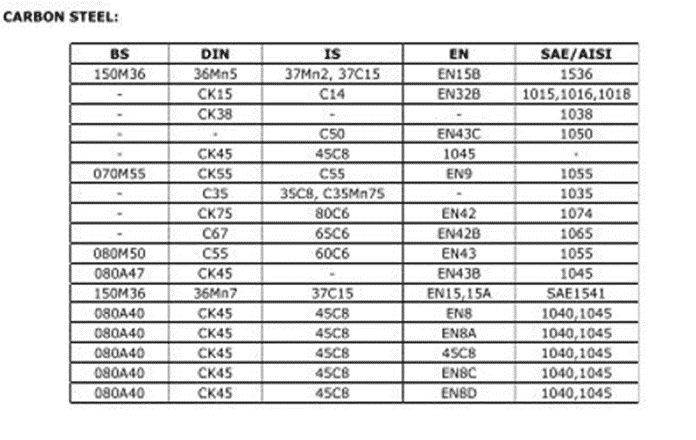Steel standards are classification, evaluation, and specification systems for chemical, mechanical, and metallurgical characteristics of various types of steels and ferrous alloys used in the manufacturing of components, machines, and structures. Steel standards aid metallurgical labs, producers, and end-users in the production, processing, and use of steel.
Steels can be classified by a large variety of criteria, such as:
- Composition; carbon, low-alloy, or stainless steel
- Manufacturing method; basic oxygen process, or electric arc furnace methods etc.
- Finishing methods; cold or hot rolling and various surface finishing and platting techniques
- Final Product; sheet, structural shape, bar, wire, plate, strip, tubing
- Microstructure; ferritic, pearlitic or martensitic
- Heat treatment method; tempering, annealing and quenching.
However, there is no universally accepted steel standard or classification system. Instead, there are a variety of approved and widely used classification and identification systems that are established and standardized either nationally and globally by Standards Development Organizations (SDOs) or by certain vertical sectors or suppliers.
The following are some of the most often used steel standard and classification systems:
AISI-SAE (American Iron and Steel Institute – The Society of Automotive Engineers):
AISI-SAE steel standards, which have been used in the United States and abroad since 1941 for the classification of steel materials. The steelmaking process is denoted by a letter prefix in the AISI system. Steels made in an open-hearth furnace, electric arc furnace, or basic oxygen furnace are designated by the prefix “C,” whereas steels made in an electric arc furnace are designated by the prefix “E.” The letter “L” in the grade name denotes the presence of lead as an additional component. Although this standard is no longer maintained and has been largely supplanted by SAE, ASTM, and other American standards, it is still widely used.
Euronorm (EN):
Euronorm (also known as the European Standard) is an international technical standard that has been accepted as applicable throughout the European Union for a wide range of commercial and industrial operations. The standards may be identical to ISO or IEC worldwide standards, or they may have editorial or technical content modifications for European Union application, with revisions attached to the international standard, or they may be developed by a European standards organization. Despite the fact that it is widely acknowledged and effective in many European nations, “obsolete” national systems like German DIN, British BS, French AFNOR, and Italian UNI are still widely utilized and frequently seen in many papers and specifications.
Japanese Steel Standards (JIS):
JIS steel standards are widely used throughout Asia and the Pacific. Other national systems, such as Korean, Chinese, and Taiwanese standards, have frequently adopted JIS steel requirements as a foundation. For the steel material number, the Japanese Industrial Standard (JIS) is separated into two types:
(1) Structural Steel: The material number is the same as with CNS. Example: S30C means carbon content 0.30% of structural steel.
(2) Other use of carbon steel and alloy steel: This kind of material code is divided into three parts. The first part denotes material. The second part denotes steel specification or use and the third part denotes type of steel material.
American Society for Testing and Materials / American Society of Mechanical Engineers ASTM (ASME)
Steel standards from ASTM are used to classify, evaluate, and specify the material, chemical, mechanical, and metallurgical properties of various types of steels, which are mainly used in the manufacturing of mechanical components, industrial parts, and construction elements, as well as many other associated equipment. Carbon, structural, stainless, ferritic, austenitic, and alloy steels are among the options. These steel standards help metallurgical laboratories and refineries, product makers, and other end-users of steel and its variations in ensuring quality and safe usage through correct processing and application processes. The ASTM standard is a commonly used material specification that focuses on product features and performance.
Deutsches Institut fur Normung e.V (DIN)
DIN used to stand for Deutsch Industrienorm (German Industry Standard), but it now stands for Deutsches Institut für Normung. The International Organization for Standardization updated this in Euronorm 27-74 in 1974. Letters and numbers are used to classify things. The letters denote the steel type, smelting technique, alloy materials, and processing condition, while the numerals denote the steel material, carbon content, tensile strength, and element fixed-point number of the primary alloy.
Other Steel Standards
Steel standards from recently industrialized nations, such as Chinese GB and YB, Indian IS, and Brazilian NBR, are currently being recognised due to global procurement, despite being less established and comprehensive at times. The same may be said about Russian GOST, which is the de facto standard for the entire Commonwealth of Independent States.
Vertical industrial steel standards include SAE for automotive, aerospace and more; ASME for pressure vessels and many other applications; AWS for welding consumables and related materials. Shipbuilding specifications are covered by the American ABS, British Lloyds, Italian RINA and others.
Numerous steel producers and suppliers have created their own unique, commercial designations for distinguishing steels in addition to the many standards listed above. After years and decades of usage, several of these identifiers have become extensively used within the industrial world, and are frequently referred to as common names or trade names without really referring to the specific provider. Because these “common” names are rarely standardized, and their characteristics can vary greatly, their use in formal technical publications should be avoided.
Also, cross-reference tables can be utilized in order to figure out which steel grade standard is equivalent to another one. One example for such a table is given below.

You may interest in this article, check out: ASME Stamp and Its Importance for Pressure Vessels
References
https://www.tien-i.com/blog_detail/27-steel-standard-comparison-cns-jis-aisi-astm-din
https://www.totalmateria.com/page.aspx?ID=SteelStandards&LN=EN
https://en.wikipedia.org/wiki/Euronorm
https://en.wikipedia.org/wiki/SAE_steel_grades


